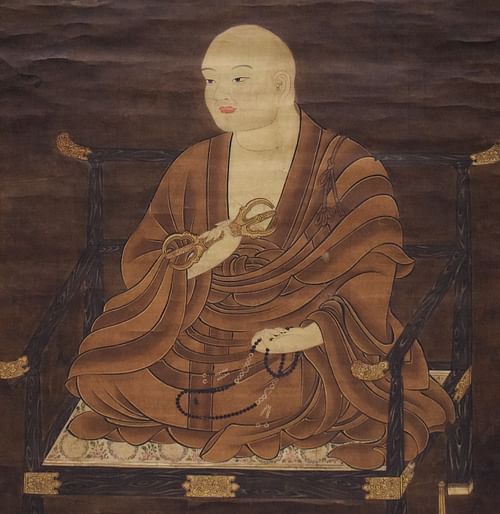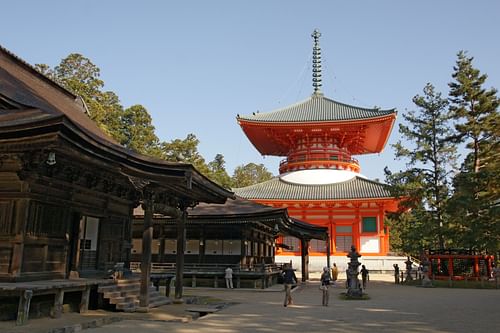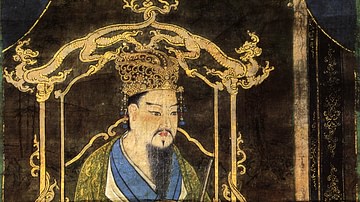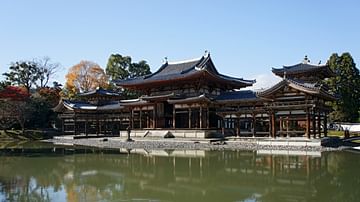
Kukai or Kobo Daishi (774-835 CE) was a scholar, poet, and monk who founded Shingon Buddhism in Japan. The monk became the country's most important Buddhist saint and has been credited with all manner of minor miracles. Noted as a gifted sculptor and the inventor of Japanese writing, he also created the most important pilgrimage route still followed by believers today.
Early Life
Kukai was born in 774 CE to a family by the name of Saeki in Sanuki Province, Shikoku which had been exiled from the capital Heiankyo (Kyoto). He adopted the name Kukai, meaning 'air-sea' when he joined, still a youth, a Buddhist monastery. When just seven years old, he was said to have climbed a mountain and, at the summit, declared, "If I am destined to serve the Law, let me be saved, otherwise let me die" (Ashkenazi, 202). He then threw himself off the cliff but was indeed saved by a group of heavenly beings who caught the boy and gently lowered him to safety. In another legend, when he was performing an austere ritual the morning star descended and jumped into his mouth, a sign that Kukai was a saint and destined for great things.
In a more historically reliable account of Kukai's early life, he was taught the Chinese classics and poetry by his uncle and entered into a Confucian college in the capital in 791 CE. There he encountered a monk who first raised his interest in Buddhism by revealing a technique of repetition to better remember texts. The young man decided to join the priesthood, and his deliberations on the merits of the three main schools of thought - Buddhism, Confucianism, and Taoism - are set out in his Indications, a fictional discussion, written c. 798 CE, between three men, each one representing one of the three branches of philosophy. Needless to say, the Buddhist is the more convincing of the three.
Shingon Buddhism
Kukai's studies of Chinese classics at the capital allowed him to visit China as part of a diplomatic embassy between 804 and 806 CE. He studied there under the master Hui-kuo, abbot of the Ching Lung (Green Dragon) Temple, was chosen as the master's successor and was suitably initiated. Thus he became an advocate of esoteric Buddhism or mikkyo, which meant that only the initiated, only those who gave up their worldly life and resided in a monastery, could know the Buddha and so achieve full enlightenment.
The Shingon (or 'True Word') Sect which Kukai studied in China (there known as Quen-yen) had made its way from southern India. It held that Buddhist teachings came from the cosmic Buddha Mahavairocana (Dainichi to the Japanese). In particular, the works of Kukai, such as the Shorai Mokuroku ('A Memorial Presenting a List of Newly Imported Sutras'), stipulated that ideal leadership should not be based on Confucian principles, as was hitherto the case, but on the teachings of the Buddha which would be revealed to an emperor on his succession following certain esoteric initiation rites. Consequently, priests, with their privileged knowledge, had the highest status in the state according to Kukai, higher even than emperors.
Crucially, Shingon Buddhism proposed that an individual could achieve enlightenment in their own lifetime and need not wait for death. Rituals included meditation carried out while the body was held in various postures, sacred hand gestures (mudras), and the repetition of secret formulas or mantras. Great importance was given to the power of prayer.
Despite Kukai's own aristocratic background, he was known to have practised what he preached and lived the life of an ascetic, as reflected in this poem from the Seirei Shu ('Collected Inspirations'), an anthology of his works compiled by his disciple Shinzei:
Valley water - one cup in the morning sustains life;
Mountain mist - one whiff in the evening nurtures the soul.
Hanging moss, delicate grasses suffice to clothe my body;
Rose leaves, cedar bark - these will be my bedding.
Heaven's compassion spreads over me the indigo canopy of the sky;
The Dragon King's devotion passes round me curtains of white clouds.
Mountain birds sometimes come, each singing its own song;
Mountain monkeys nimbly leap, displaying incredible skill.
Spring flowers, autumn chrysanthemums smile at me;
Dawn moons, morning winds cleanse the dust from my heart.
(Keene, 187)
In 819 CE the monk created a centre for his esoteric doctrine on Mount Koya (in the modern Wakayama Prefecture). The temple there is still today the headquarters of the Shingon Buddhist Sect. Here educated devotees could reach enlightenment, it was promised, not by the lifelong study of sutras but by performing various rituals and viewing mandalas, the stylised visual representation of the teachings of Buddha. Kukai had brought back examples of these paintings from his China trip and they commonly portrayed divinities and mystic symbols. The very act of creating mandalas was considered a religious rite and so the images were thought to contain the embodiment of the deities they portrayed. In 823 CE, Emperor Saga (r. 809-823 CE) granted the founding of the Toji ('Eastern') temple at Minami-ku in Kyoto, thus indicating that Shingon Buddhism had become an accepted part of the official state religion.
Miracles
Kukai also established a route of pilgrimage - the longest and most famous in Japan - which is a 1,600 km (1,000 miles) circuit which stops at 88 temples. Besides these more practical achievements, Kukai was credited with many miracles. Known as a great sculptor - there are still several trees in Japan said to have been sculpted by him into figures from Buddhism - he once cured a dying farmer by using his sickle to sculpt a self-likeness and on another occasion miraculously carved a statue of Yakushi, the Buddha of healing, using only his fingernails. The monk was also adept at creating sources of fresh water where they were most needed and of ridding places of demons and troublesome animals like foxes and snakes. Finally, Kukai is thought to protect any pilgrims following his circuit and he provides for any children born while their parents are on it.
Kukai the Scholar
Kukai was, above all, a scholar and he compiled detailed histories of religious thought in both China and India. He wrote the semi-autobiographical Sango shiiki ('Indications of the Goals of the Three Teachings') in 797 CE. Kukai was also a poet of some repute, and he wrote a guide on the rules of Chinese poetry. He was a fine calligrapher, too, and is credited by some (without any evidence) as inventing the kana script, that is Japanese writing using Chinese characters phonetically.
Kukai died in 835 CE - he had predicted the very day - and was buried in a tomb on Mount Koya. After his death, the emperor dreamt that Kukai called to him for a new robe. The emperor acted on the vision and opened up the monk's tomb. Sure enough, there was Kukai looking a little worse for wear in a tattered robe. Freshened up and reclothed, Kukai then made a prediction that the future Buddha, Miroku, would reappear on earth in 5,670,000,300 years. In 921 CE Kukai was given the posthumous title of Kobo Daishi meaning 'Great Teacher of Spreading the Law' by the emperor. The mausoleum of Kukai is today part of the Koyasan temple complex at Mount Koya which is a UNESCO World Heritage Site.
This content was made possible with generous support from the Great Britain Sasakawa Foundation.






